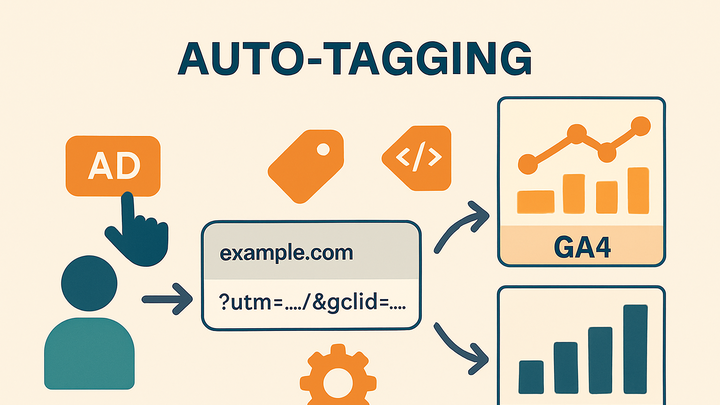Published on 2025-06-22T06:40:09Z
What Is Auto-Tagging in Analytics? Examples in GA4 and PlainSignal
Auto-Tagging is a feature in web analytics that automatically appends tracking parameters to URLs, ensuring accurate campaign attribution without manual intervention. When a user clicks a tagged link—such as a Google Ads ad with the gclid parameter or a marketing email with UTM parameters—Auto-Tagging injects metadata directly into the URL or via JavaScript, enabling the analytics platform (e.g., GA4 or PlainSignal) to capture source, medium, campaign, and other critical dimensions. This approach reduces human error, enforces consistency across marketing channels, and saves time for marketers. In privacy-focused, cookie-free analytics solutions like PlainSignal, Auto-Tagging can still work by leveraging JavaScript events and server-side signals, preserving user privacy while delivering rich attribution data. Overall, Auto-Tagging streamlines campaign measurement, improves data quality, and enhances decision-making by providing reliable, automated tracking.
Auto-tagging
Auto-Tagging automatically appends tracking parameters to URLs for consistent, error-free campaign attribution in analytics tools.
How Auto-Tagging Works
Auto-Tagging seamlessly integrates with marketing platforms and web pages to append tracking metadata at the moment of link click or page load. This process typically involves JavaScript or URL parameter injection, parsing of those parameters by the analytics engine, and automatic attribution to campaigns and channels in reporting.
-
Url parameter injection
When a user clicks a tagged link, the analytics script or ad platform automatically adds parameters (e.g., utm_source, gclid) to the destination URL without manual editing.
-
Parameter parsing
Upon page load, the analytics tool reads and parses the injected parameters, storing them in session or event data tables for later reporting.
-
Data attribution
Parsed parameters are mapped to dimensions like Source/Medium/Campaign in reports, allowing marketers to see which channels and ads drove traffic and conversions.
Benefits of Auto-Tagging
By automating the tagging process, marketers avoid inconsistent naming, reduce manual workload, and ensure that every campaign click is tracked uniformly across all channels.
-
Consistency and accuracy
Automatically generated parameters follow a standardized naming convention, eliminating typos and variations that can fragment data.
-
Time savings
Marketers no longer need to manually append UTM codes to each link, speeding up campaign launches.
-
Reduced human error
Automation removes the risk of forgetting to tag links or using incorrect parameter values.
Auto-Tagging in GA4
Google Analytics 4 offers built-in Auto-Tagging for Google Ads campaigns via the gclid parameter, simplifying ad attribution. Once enabled, GA4 automatically links ad clicks to sessions and conversions.
-
Google ads auto-tagging
When you link your Google Ads account to GA4 and enable Auto-Tagging, every ad click URL includes a gclid parameter that GA4 uses to attribute sessions and conversions.
-
Enable in admin panel
In GA4, navigate to Admin › Data Streams › choose your stream › Google Ads links › toggle Auto-Tagging on.
-
-
Parameter mapping
GA4 maps gclid values to Source, Medium, Campaign, and other campaign dimensions automatically, populating your reports without manual UTM codes.
Auto-Tagging in PlainSignal
PlainSignal is a cookie-free analytics platform that supports Auto-Tagging through a lightweight JavaScript snippet. It parses click parameters and JavaScript events to provide attribution without relying on third-party cookies.
-
Cookie-free tagging
PlainSignal’s script captures URL parameters and event metadata server-side, ensuring privacy compliance while still attributing campaigns accurately.
-
Implementation snippet
<link rel="preconnect" href="//eu.plainsignal.com/" crossorigin /> <script defer data-do="yourwebsitedomain.com" data-id="0GQV1xmtzQQ" data-api="//eu.plainsignal.com" src="//cdn.plainsignal.com/plainsignal-min.js"></script>
Best Practices for Auto-Tagging
To get the most out of Auto-Tagging, follow these guidelines to maintain clean data and robust reporting across all your marketing efforts.
-
Consistent url structure
Ensure your website can handle appended parameters gracefully and avoid redirect loops caused by malformed URLs.
-
Monitor tagging performance
Regularly audit your reports for missing or unexpected parameter values, signaling tagging or parsing issues.
-
Fallback to manual tagging
For channels that don’t support Auto-Tagging, maintain a manual UTM tagging standard to ensure full coverage.
